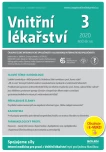Proteinuria from an internist‘s point of view
Authors:
Jan Vachek 1,2; Adéla Maříková 2; Kateřina Oulehle 2; MUDr. PhDr. Oskar Zakiyanov, PhD. 3; Vladimír Tesař 1
Authors‘ workplace:
Klinika nefrologie 1. LF UK a VFN Praha
1; Interní oddělení a hemodialyzační středisko Klatovské nemocnice, a. s., Klatovy
2; Klinika nefrologie 1. LF UK a VFN v Praze
3
Published in:
Vnitř Lék 2020; 66(3): 90-92
Category:
Overview
A basal level of proteinuria is about 30–100 mg/day, the upper limit of basal proteinuria does not exceed 150 mg/day which is considered non-pathology. Albumin accounts approximately 15 % of basal protein in the urine, other plasma proteins (immunoglobulins, β-2 microglobulin, Tamm-Horsfall mucoprotein) comprise the remaining 85 % of total quantity non-pathology proteinuria. Persistent proteinuria present for more than three months already meets the definition of chronic kidney disease independently of the stage of the estimated glomerular filtration rate. Patients are classified as A1–A3 based on the level of albuminuria. Examination of the albumin in the urine is one of the single sensitive indicators of chronic kidney disease. Proteinuria is an independent risk factor for cardiovascular disease, overall mortality and end stage renal failure both in general population and in population with chronic kidney disease. Presence of the urinary protein is associated with a higher mortality rate in critically ill patients. The degree of proteinuria after kidney transplantation predicts graft and patient survival in this population. Pharmacological and non-pharmacological treatments that attenuate proteinuria have been associated with better prognosis of kidney disease.
Keywords:
albuminuria – Proteinuria – glomerulopathy – Creatinine – protein/creatinine ratio
Sources
1. Žabka J. Diferenciální diagnostika proteinurie. In: Viklický O, Dusilová-Sulková S, Rychlík I Vyšetřovací metody v nefrologii a jejich klinická aplikace. Praha: Tigis 2007, 17-22.
2. Engliš M. Současné možnosti vyšetřování proteinurií. In: Viklický O, Dusilová-Sulková S, Rychlík I Vyšetřovací metody v nefrologii a jejich klinická aplikace. Praha: Tigis 2007, 13-15.
3. Thongboonkerd V, McLeish KR, Arthur JM et al. Proteomic analysis of human urinary proteins isolated by acetone precipitation or ultracentrifugation. Kidney Int 2002; 62 : 1461-1469.
4. Kouri T, Fogazzi G, Gant V et al. European Urinalysis Guidelines. Scand J Clin Lab Invest 2000; 60: (Suppl. 231): 1-96.
5. Lamb EJ, MacKenzie F, Stevens PE. How should proteinuria be detected and measured? Ann Clin Biochem 2009; 46 : 205-217.
6. Rodby RA, Rohde RD, Sharon Z.et al. The urine protein to creatinine ratio as a predictor of 24-hour urine protein excretion in type 1 diabetic patients with nephropathy. The Collaborative Study Group. Am J Kidney Dis 1995; 26 : 904-909.
7. Russo LM, Comper WD, Osicka TM. Mechanism of albuminuria associated with cardiovascular disease and kidney disease. Kidney Int 2004; 66: (Suppl. 92): S67-S68.
8. Levey AS et al. The definition, classification, and prognosis of chronic kidney disease: a KDIGO Controversies Conference report. Kidney Int 2011; 9 : 17-28.
9. https://www.england.nhs.uk/wp‑content/uploads/2014/06/psa‑risk‑preg‑wom.pdf (navštíveno 1. 9. 2018)
Labels
Diabetology Endocrinology Internal medicineArticle was published in
Internal Medicine

2020 Issue 3
Most read in this issue
- What is hiden behind autoinflammation?
- Local thrombolysis for deep vein thrombosis: why, for whom and how?
- Proteinuria from an internist‘s point of view
- Hepatorenal syndrome – update 2020
